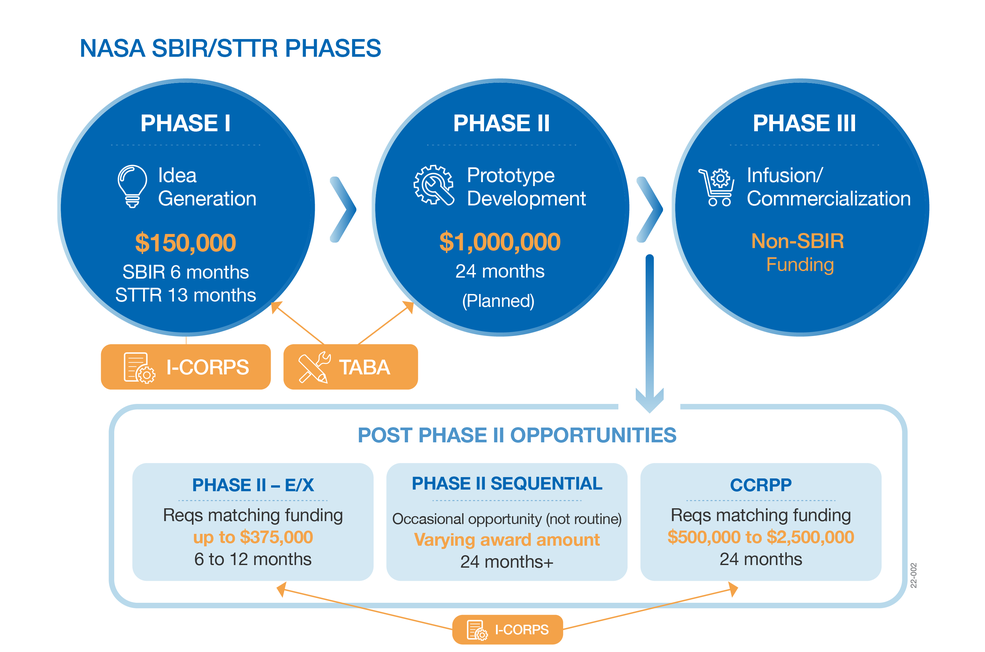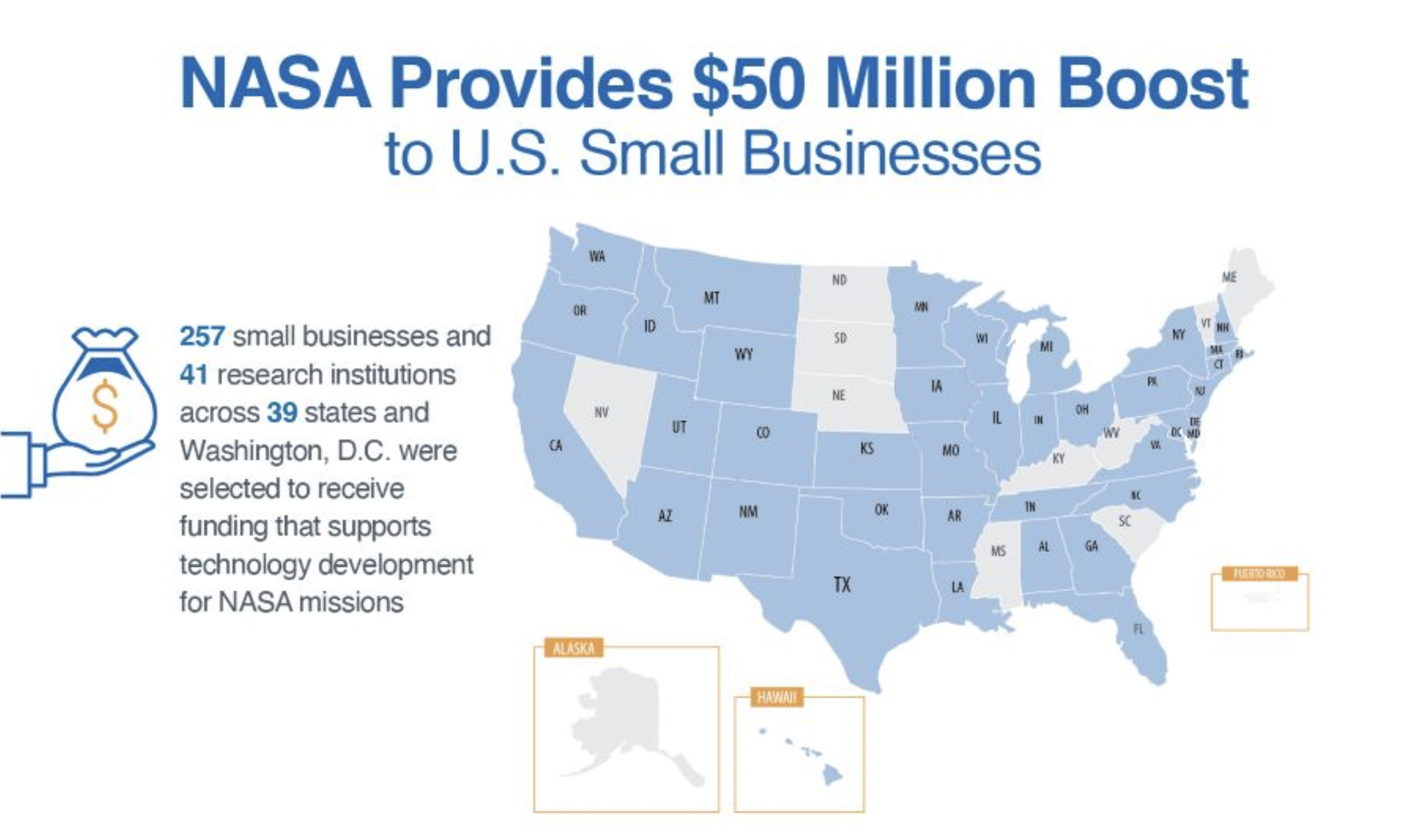Out of 333 proposals that NASA is funding as part of its 2022 Small Business Innovation Research (SBIR) and Small Business Technology Transfer (STTR) program, 24 are either creating new additive manufacturing (AM) processes or leveraging existing 3D printing technologies. Each project will receive a share of the $50 million NASA award, which is intended to develop technology to help drive the future of space exploration, as part of the agency’s Phase I development stage.
In May 2022, the agency revealed that the proposals from 257 small businesses and 41 research institutions would help address many of NASA’s challenges in human exploration, space technology, science, and aeronautics. Notably, Jenn Gustetic, Director of early-stage innovation and partnerships for NASA’s Space Technology Mission Directorate, said the uses for these technologies could even be destined for Artemis and other missions and the commercial space industry, and people’s everyday lives.
Each proposal team will receive $150,000 – a 20% increase over previous years’ funding – to establish the merit and feasibility of their innovations. Phase I SBIR contracts are awarded to small businesses and last for six months, while Phase I STTR contracts are awarded to small businesses in partnership with a research institution and last for 13 months.
In the last few years, NASA’s SBIR/STTR program has seen dozens of AM-related projects for space innovations. For example, in 2021, NASA backed 36 3D printing submissions for Phase I, and before the pandemic, the agency funded another 10 AM projects. Based on their progress during this initial stage, the companies may submit proposals for $850,000 in Phase II funding to develop a prototype and subsequent SBIR/STTR Post Phase II opportunities.
Among the innovative 3D printing undertakings this year, 3DPrint.com highlights six projects which have AM at its core:
3D Printing Anti-Radiation Construction
One of the most important upcoming sectors of the space economy is construction on the surface of the Moon or Mars. For this reason, International Scientific Technologies, in conjunction with Virginia Tech, proposes the 3D printing of regolith combined with hydrogen-rich polymers to develop radiation-shielding structural materials for human habitats.
The company proposes additively manufacturing structures on-site through in situ resource utilization (ISRU), that is, using the regolith available on the extraterrestrial surface with a minimal amount of hydrogen-rich polymeric binder, which would ideally be effective in deterring the incoming particles found in space radiation that would otherwise put crews at risk for radiation sickness, and increased lifetime risk for cancer, central nervous system effects, and degenerative diseases.
Radiation shielding is crucial for space missions, so this is one of our favorite projects selected for Phase I. Outside of NASA, this technology will find applications in the U.S. Department of Defense and Homeland Security, helping protect soldiers, first responders, and emergency medical personnel against radiation resulting from dirty bombs and hazards from accidental release of radiological materials.
3D Printed Fuel Grains
EOS Energetics (which goes by the business name Estes Energetics) is a spinoff company out of model rocket company Estes Industries that will develop a hybrid rocket motor for the next generation of sample return missions. Designed with Utah State University, the system will incorporate several unique technologies that provide the performance and reliability needed for a sample return propulsion system, including a high-capability electric ignition system, a high-performance oxidizer, and 3D printed fuel grains.
According to the proposal, novel fuels like 3D printed fuel grains give more precise control over how fast fuel will burn inside a rocket casing, so for a sample return, the thrust can be optimized for a high launch followed by an efficient cruise phase.
Aside from NASA sample return missions, other potential applications for the additively manufactured hybrid motor technology include satellite maneuvering, de-orbit propulsion, and applications where a traditionally energetic material fuel source poses safety issues.
Defect Correction for In-Space AM
Intelligent Optical Systems, a California-based startup focused on sensor solutions, will use its SBIR award to find a way to correct defects during in-space additive manufacturing. The team, led by electro-optical physicist Bradley Bobbs, will produce interrupted-build samples with simulated defects on an AM machine designed for use in space. It will then use laser ultrasonic testing (LUT) to run scans on them and further develop algorithms and software to enhance defect detection and identification from the scans.
According to the team, LUT is the only currently viable method for in-line defect detection during the AM build, so they will attempt to make preliminary assessments to show the feasibility of integrating LUT into the AM machine. In addition, the company already has plans for Phase II, which include developing and testing a prototype in-line inspection system that would ultimately enable fully qualified AM parts on the surfaces of the Moon and Mars, to support sustainable exploration there and on the International Space Station.
Off-Earth 3D Printed Data Collector
Dedicated to producing novel circuits in unique processes for rugged applications, Ozark Integrated Circuits submitted a plan to 3D print a read-only memory (ROM) to collect data that can survive at up to 500°C, which is roughly the temperature on Venus’s surface.
According to NASA, prolonged Venus surface missions (lasting months instead of hours) have proven futile due to the absence of a complete suite of electronics that can function that long without protection from the planet’s extreme conditions––think, hot enough to melt lead. The longest successful report is from NASA Glenn Research Center’s JFET-R, showing two months of operation under Venus surface conditions. However, the agency desires computational analyses on the surface of Venus to better understand its greenhouse effect atmosphere and geology, and that means prolonged missions.
Ozark’s project will attempt to design, simulate, package, and characterize an all-additive ROM technology based on qualified materials up to technology readiness level (TRL)-5 in previous NASA SBIR programs. The system could also be helpful for other high-temperature environments, like Mercury, high-temperature avionics, re-entry, propulsion sensing, and controls, along with any application that needs very high-temperature data collection from geothermal exploration to health monitoring of molten salt reactors.
Lunar Construction
Another project that deals with off-Earth construction is Lunar Resources’ proposal of a novel 3D printing construction system for the Moon. The innovative technique combines unique mass control in an ultra-energy-efficient pulsed power printing headset to perform direct additive manufacturing of lunar regolith without any reagents.
If effective, the technology would allow 3D printing of lunar structures from lunar regolith and in-situ derivative materials by printing from any direction to make structures with geometries and complexity not before possible on the Moon. Specific NASA applications include manufacturing large-scale complex structures such as landing pads, habitats, roads, walls, shields, berms, and beams.
Based in Houston, Lunar Resources is a corporate spinoff from various NASA and NASA-sponsored technology development programs and is focused on developing and commercializing space manufacturing and resource extraction technologies to catalyze the space economy. The company has been developing 3D printers for a while, mainly to repair broken satellites or build new ones (while orbiting Earth), but it’s hoping its resource extraction technologies will allow the U.S. to create a permanent presence on the Moon.
AM for Spacesuits and Structures
Under two STTR awards, Nanosonic will partner with Virginia Tech. Together, they will develop nanolayered extruded textiles for next-generation spacewalking suits (or xEMUs), which will benefit several space programs, namely the International Space Station, Human Landing System, Artemis, Gateway, and Orion. In their second undertaking, Nanosonic will team up with Virginia Tech’s composite coding experts to predictively yield repeatable and reliable multifunctional lightweight hybrid structures through design tools.
Highly tailored materials using AM techniques are Nanosonic’s expertise. The company is leading the development of innovative high-performance polymer composites through new 3D printing methods, including reactive nano-layered extrusion, FFF, and filament winding. For more than ten years, Nanosonic has used AM to create a wide range of applications, including RF components on flexible substrates. Together with Virginia Tech’s AM expertise, they plan to synergistically blend and develop some of the applications NASA needs for space exploration.
Other proposed research and development initiatives include a novel 3D printing technique to manufacture ultra-high temperature ceramic matrix composites with microgravity improved grain structure by Nanoarmor; an in-process X-ray sensor that can detect defects of AM parts by Advanced Analyzer Labs, and Polaronyx’s additively manufactured radiation-tolerant bearing for deep-atmospheric probes destined to giant planets.
Subscribe to Our Email Newsletter
Stay up-to-date on all the latest news from the 3D printing industry and receive information and offers from third party vendors.
You May Also Like
3D Printing News Briefs, April 13, 2024: Robotics, Orthotics, & Hypersonics
In 3D Printing News Briefs today, we’re focusing first on robotics, as Carnegie Mellon University’s new Robotics Innovation Center will house several community outreach programs, and Ugogo3D is now working...
Rail Giant Alstom Saves $15M with 3D Printing Automation Software 3D Spark
3D Spark has entered into a three-year deal with the rail giant Alstom. Alstom, a transport behemoth with annual revenues of $16 billion, specializes in the manufacture of trains, trams,...
Meltio Expands Global Reach with New Partnerships in the Americas and Europe
Spanish 3D printing manufacturer Meltio has expanded its sales network across the globe. With the addition of three new partners in the United States, Brazil, Argentina, and Italy, Meltio aims...
3D Printing Webinar and Event Roundup: April 7, 2024
Webinars and events in the 3D printing industry are picking back up this week! Sea-Air-Space is coming to Maryland, and SAE International is sponsoring a 3D Systems webinar about 3D...

































